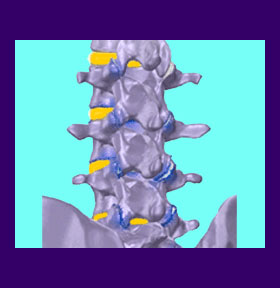
Chiropractic for arthritis is one of the most common uses of manual spinal adjustments in middle aged to elderly patients. In some instances, chiropractic seeks to treat arthritic changes directly, while in others, the usual spinal adjustments might bring relief even though they do not specifically target regions of arthritic activity.
Osteoarthritis is virtually universal in the spine. The arthritic processes are normal results of aging and affect many of the spinal structures, including spinal joints and the actual vertebral bones. Spinal arthritis is usually theorized to cause pain through spinal stenosis, foraminal stenosis, facet joint syndrome, mechanical interactions and other possible processes. However, in some cases, arthritis is mildly symptomatic, or completely asymptomatic, leading to misdiagnosis of many patients who are pronounced with arthritic back pain. In these circumstances, the osteoarthritic changes certainly are present. However, these normal anatomical alterations are not the true origin of pain.
This commentary investigates the positive aspects of arthritis care using chiropractic, as well as the limitations of manual spinal adjustments.
Chiropractic for Arthritis Facts
Arthritis enacts easily proven structural changes to the spinal components. Bones will grow spurs and joints will lose their protective mechanisms, leading to increased friction and hard-surface interactions. Chiropractic will not undo these degenerative changes and may even accelerate some of them, since specific adjustments have been implicated as being traumatic to the joints.
Chiropractic does seem to help maintain movement and functionality in stiff joints, which can facilitate resolution of pain in some cases.
Chiropractic will not generally cure any arthritis, but may provide the temporary relief that is experienced by so many patients who are diagnosed with a wide range of back and neck pain syndromes. Whether this relief is anatomically-based or due to mindbody placebo is open to interpretation in many cases, especially when the actual source of pain is misdiagnosed as coming from arthritis alone.
Chiropractic Treatment for Arthritis
Chiropractors want to help create ideal health and will do their best to treat patients using all the tools at their disposal. However, when it comes to many types of actual arthritis pain, treatment may prove to be very uncomfortable. This is particularly true of the rare cases of mechanical back pain that are sourced by problematic osteophytes that have formed on the facet joints. Adjustments may be more painful than they are worth for some patients.
Bone spurs may also grow on or around the vertebral bones, often indicated as endplate changes on spinal MRI imaging films. These osteophytes are most often innocent and not the reason for any chronic pain, although they are sometimes mistakenly targeted as the cause of lasting symptoms.
Of course, some bone spurring in the joints, or on the vertebral bodies, can be highly problematic in rare circumstances. However, for laymen patients, it is virtually impossible to know when these circumstances exist and when the arthritis is being blamed unjustly for enacting their suffering. It can be a very confusing process indeed, regardless of what type of treatment is sought.
It is also important to remember that spinal stenosis, due to arthritic change, is normal to experience as we age and most cases are not overly symptomatic. Likewise, bone spurs that narrow the neuroforamen are not usually problematic, unless the loss of patency definitively compresses exiting nerve roots. Chiropractic may go about treating these structural changes, but this does not mean that the conditions actually require treatment, per se.
Chiropractic for Arthritis Opinions
Is chiropractic a good solution for arthritis? Well, this depends on many factors and points of view. If chiropractic helps to reduce pain, and provides relief without using drugs, then it is worthwhile. However, if you are more interested in finding a lasting cure or a finite treatment regimen, then you may be pursuing the wrong type of care.
Chiropractic is a health maintenance program which must be continuously used in order to be potentially effective. Each adjustment only delivers relief for a short time frame, for those who enjoy relief at all. If you do not mind continuing care, or even prefer it, then chiropractic might be the right path for you.
Unfortunately, there is no definitive summation on whether or not chiropractic is good or bad for treating spinal osteoarthritis. There is propaganda on both sides of the equation, with chiropractors claiming positive benefits and many medical professionals claiming degenerative effects of spinal manipulation. I guess the best one can do is to learn all the facts for themselves and then make up their own mind about the truth they choose to embrace.





